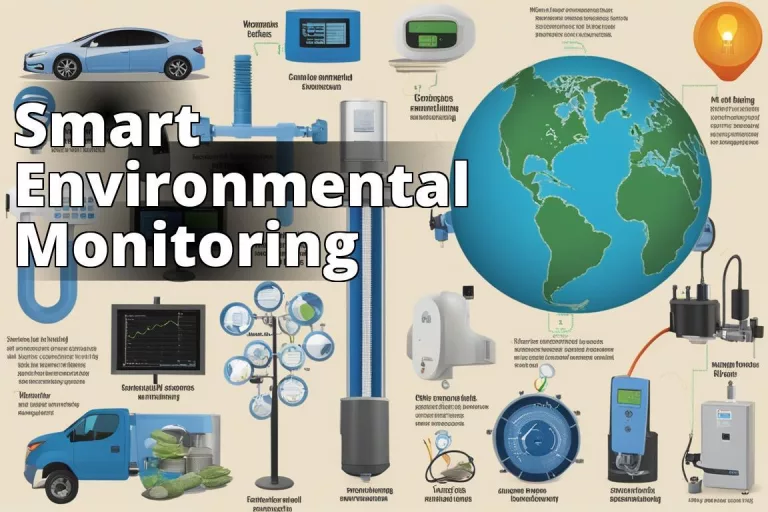IoT for environmental monitoring is the process of collecting and analyzing data from environmental sensors using Internet-of-Things (IoT) technology. It involves the deployment of sensors that can measure various parameters such as air quality, water quality, soil conditions, noise levels, and more. These sensors are connected to a network and can transmit data in real-time, allowing for continuous monitoring and analysis.
With IoT devices for environmental monitoring, we can gather valuable insights about our environment, identify potential issues, and take timely actions to mitigate them. This technology enables us to have a deeper understanding of our surroundings and make informed decisions for the betterment of our planet.
How Does IoT for Environmental Monitoring Work?
At its core, IoT for environmental monitoring relies on a network of sensors that are strategically placed to collect data from the environment. These sensors can be installed in various locations, such as homes, offices, public spaces, and even remote areas. They are designed to measure specific parameters, such as temperature, humidity, air pollutants, water contaminants, and more.
The collected data from IoT sensors is then transmitted to a central hub or cloud-based platform using wireless connectivity, such as Wi-Fi or cellular networks. This allows for real-time monitoring and analysis of the environmental conditions. Advanced analytics algorithms are employed to process the data, identify patterns, and generate meaningful insights.
For example, in air quality monitoring, IoT sensors can detect the presence of pollutants such as carbon dioxide, nitrogen dioxide, and particulate matter. This data can be analyzed to assess air quality levels and identify areas with high pollution levels.
What Are the Benefits of using IoT for Environmental Monitoring?
IoT for environmental monitoring offers a range of benefits that can have a significant impact on our environment and our lives. Here are some of the key advantages:
1. Early Detection of Environmental Issues
By continuously monitoring environmental parameters, IoT technologies enable us to detect issues at an early stage. For example, if a water quality sensor detects an increase in contaminants, immediate action can be taken to prevent further contamination and protect public health. Early detection allows for timely interventions, minimizing the potential damage to ecosystems and human health.
2. Improved Resource Management
IoT systems for environmental monitoring provides valuable insights into the utilization of natural resources. For instance, by monitoring soil moisture levels, farmers can optimize irrigation and reduce water waste. Similarly, by monitoring energy consumption in buildings, energy efficiency can be improved, leading to reduced carbon emissions and cost savings.
3. Enhanced Public Health and Safety
Continuous monitoring of air quality, water quality, and noise pollution levels can have a direct impact on public health and safety. By identifying areas with poor air quality or high noise levels, appropriate measures can be taken to mitigate the risks and improve the well-being of individuals. This is particularly important in urban areas where pollution and noise pollution are major concerns.
4. Data-Driven Decision Making
IoT for environmental monitoring generates a wealth of data that can be analyzed and used to make informed decisions. This data can help policymakers, businesses, and individuals understand the impact of their actions on the environment and guide them in adopting more sustainable practices. For example, by analyzing data on waste generation and recycling rates, municipalities can develop effective waste management strategies.
Read more: E-waste Management and Recycling: an overview
Related article: Environmental Data and Indigenous Data Sovereignty
5. Increased Efficiency and Cost Savings
By automating the collection and analysis of environmental data, IoT environmental monitoring systems can significantly reduce the time and effort required for manual monitoring. This leads to increased efficiency and cost savings, as fewer resources are needed for data collection and analysis. Moreover, real-time monitoring allows for proactive measures to be taken, reducing the potential costs associated with environmental damage.
What Are the Applications of IoT for Environmental Monitoring?
IoT environmental monitoring has a wide range of applications across various sectors. Here are some of the key areas where this technology is being used:
1. Air Quality Monitoring
Air pollution is a major concern in many parts of the world, and IoT systems for environmental monitoring plays a crucial role in addressing this issue. By deploying air quality sensors in urban areas, we can monitor pollution levels and identify sources of pollution. This data can be used to develop effective air quality management strategies and reduce the impact of air pollution on public health.
2. Water Quality Monitoring
Ensuring the safety of our water resources is vital for public health and ecosystem preservation. IoT systems for environmental monitoring enables continuous monitoring of water quality parameters, such as pH levels, dissolved oxygen, and contaminants. This data helps in identifying sources of pollution, assessing the health of aquatic ecosystems, and ensuring the safety of drinking water sources.
Read more: IoT for Water Quality Monitoring
3. Soil Quality Monitoring
Healthy soil is essential for agriculture and sustainable land management. IoT environmental monitoring allows for the continuous monitoring of soil parameters, such as moisture levels, nutrient content, and pH levels. This data helps farmers optimize irrigation and fertilization practices, prevent soil erosion, and improve crop yields.
4. Noise Pollution Monitoring
Excessive noise can have a detrimental impact on human health and well-being. IoT environmental monitoring enables the continuous monitoring of noise levels in urban areas, workplaces, and public spaces. This data can be used to identify areas with high noise pollution levels and develop strategies to mitigate the impact on individuals.
Read more: Noise Monitoring Technologies
5. Waste Management
Effective waste management is crucial for reducing the environmental impact of waste and promoting recycling and resource recovery. IoT environmental monitoring systems can be used to track waste generation, monitor recycling rates, and optimize waste collection and disposal processes. This data helps in developing efficient waste management strategies and reducing the amount of waste sent to landfills.
Read more: E-waste Management and Recycling: an overview
What Are the Challenges of IoT for Environmental Monitoring?
While IoT environmental monitoring offers significant benefits, it also comes with its own set of challenges. Here are some of the key challenges:
1. Data Security and Privacy
IoT environmental monitoring systems involve the collection and transmission of sensitive data. Ensuring the security and privacy of this data is of utmost importance. There is a need for robust data encryption, secure communication protocols, and strict access controls to protect the integrity and confidentiality of the collected data.
2. Scalability and Interoperability
As IoT environmental monitoring systems grow in scale, managing a large number of sensors and devices becomes challenging. Ensuring interoperability between different sensors, platforms, and communication protocols is crucial for seamless data collection and analysis. Scalable and flexible architectures are needed to accommodate the increasing volume of data and devices.
3. Data Accuracy and Reliability
The accuracy and reliability of the collected data are critical for making informed decisions. Sensor calibration, data validation, and quality assurance processes are essential to ensure the accuracy and reliability of the collected data. Regular maintenance and calibration of sensors are necessary to minimize measurement errors and data discrepancies.
4. Power Management
IoT sensors require power to operate, and managing power consumption is a key challenge. Battery life optimization, energy-efficient sensor designs, and power management techniques are essential for extending the operational life of sensors. In some cases, renewable energy sources, such as solar panels, can be used to power the sensors, reducing the reliance on traditional energy sources.
5. Cost Considerations
Deploying and maintaining IoT environmental monitoring systems can be costly. The cost of sensors, communication infrastructure, data storage, and analytics platforms needs to be carefully considered. Cost-effective solutions, such as sensor networks and cloud-based platforms, can help reduce the overall cost of implementing IoT environmental monitoring systems.
What Are the Best Practices for IoT for Environmental Monitoring?
To ensure the success of IoT environmental monitoring projects, it is important to follow best practices. Here are some key practices to consider:
1. Clearly Define Objectives and Metrics
Before implementing an IoT environmental monitoring system, it is important to clearly define the objectives and metrics that will be used to measure success. This includes identifying the parameters to be monitored, the desired level of accuracy, and the specific goals to be achieved. By clearly defining objectives and metrics, it becomes easier to assess the effectiveness of the monitoring system and make data-driven decisions.
2. Choose the Right Sensors and Technologies
Selecting the right sensors and technologies is crucial for accurate and reliable data collection. Consider factors such as the measurement range, sensitivity, and environmental conditions when choosing sensors. Similarly, choose communication technologies that are suitable for the deployment environment, such as Wi-Fi, cellular networks, or LoRaWAN. A careful evaluation of available options will help ensure the success of the monitoring system.
3. Establish Data Validation and Quality Assurance Processes
To ensure the accuracy and reliability of collected data, establish data validation and quality assurance processes. This includes regular calibration of sensors, validation of data against known standards or reference measurements, and quality control checks. These processes help identify and correct measurement errors, ensuring that the collected data is of high quality and fit for analysis.
4. Consider Scalability and Integration
When designing an IoT environmental monitoring system, consider scalability and integration from the outset. Plan for the future growth of the system and ensure that it can accommodate an increasing number of sensors and devices. Similarly, design the system to be interoperable with other systems and platforms, enabling seamless integration and data exchange.
5. Ensure Data Security and Privacy
Protecting the security and privacy of collected data should be a top priority. Implement robust data encryption, secure communication protocols, and strict access controls to prevent unauthorized access and data breaches. Regularly update security measures and stay informed about the latest security threats and best practices.
What Are the Key Components of an IoT for Environmental Monitoring System?
An IoT environmental monitoring system consists of several key components that work together to collect, transmit, and analyze environmental data. Here are the main components:
1. Sensors
Sensors are at the heart of an IoT environmental monitoring system. They are responsible for measuring various environmental parameters, such as temperature, humidity, air pollutants, water contaminants, and more. Sensors can be deployed in various locations, such as homes, offices, public spaces, and remote areas, depending on the specific monitoring requirements.
2. Communication Infrastructure
A robust communication infrastructure is essential for transmitting data from sensors to a central hub or cloud-based platform. This infrastructure can include wireless technologies such as Wi-Fi, cellular networks, or low-power wide-area networks (LPWAN). The choice of communication technology depends on factors such as the distance between sensors and the central hub, power requirements, and data transmission rates.
3. Data Storage and Management
The collected data needs to be stored and managed in a secure and efficient manner. Cloud-based platforms are often used for data storage and management, as they offer scalability, flexibility, and accessibility from anywhere. These platforms enable real-time data analysis, visualization, and reporting, making it easier to derive insights and take informed actions.
4. Analytics and Visualization
Advanced analytics algorithms are used to process the collected data and generate meaningful insights. These algorithms can identify patterns, trends, and anomalies in the data, allowing for informed decision making. Data visualization tools are also used to present the analyzed data in an easy-to-understand format, enabling stakeholders to gain insights at a glance.
5. User Interfaces and Applications
User interfaces and applications provide a means for stakeholders to interact with the IoT environmental monitoring system. These interfaces can include web-based dashboards, mobile applications, and APIs (Application Programming Interfaces) for integration with other systems. User interfaces and applications enable stakeholders to monitor environmental conditions, receive alerts, and access historical data.
How Can IoT for Environmental Monitoring Help Your Business?
IoT environmental monitoring can bring significant benefits to businesses across various industries. Here are some ways in which it can help:
1. Compliance with Environmental Regulations
Many industries are subject to environmental regulations that require them to monitor and manage their environmental impact. IoT environmental monitoring can help businesses ensure compliance with these regulations by providing real-time data on environmental parameters. This data can be used to demonstrate compliance and identify areas for improvement.
2. Risk Management and Prevention
Monitoring environmental conditions can help businesses identify potential risks and take preventive measures. For example, in industries where air pollution is a concern, continuous air quality monitoring can help identify sources of pollution and take corrective actions to prevent environmental damage and potential penalties.
3. Resource Optimization and Cost Savings
By monitoring resource utilization, businesses can identify opportunities for optimization and cost savings. For instance, by monitoring energy consumption in manufacturing processes, businesses can identify energy-saving opportunities and reduce operational costs. Similarly, by monitoring water usage, businesses can optimize water consumption and reduce costs associated with water supply and treatment.
4. Brand Reputation and Customer Engagement
Demonstrating a commitment to environmental sustainability can enhance a business’s reputation and engage customers. IoT environmental monitoring can help businesses track and communicate their environmental performance, such as reduced carbon emissions or improved air quality in their facilities. This can attract environmentally conscious customers and differentiate the business from competitors.
5. Innovation and Product Development
IoT environmental monitoring can provide businesses with valuable insights for innovation and product development. By understanding the environmental impact of their products and services, businesses can identify opportunities for improvement and develop more sustainable offerings. This can lead to the development of new revenue streams and increased competitiveness in the market.
In conclusion, IoT environmental monitoring is a powerful tool that can help us better understand and manage our environment. By continuously monitoring environmental parameters, we can detect issues at an early stage, optimize resource utilization, and improve public health and safety. However, implementing and managing IoT environmental monitoring systems comes with its own set of challenges, including data security, scalability, and cost considerations. By following best practices and leveraging the key components of an IoT environmental monitoring system, businesses can harness the benefits of this technology and contribute to a more sustainable future.
Answers To Common Questions
What is IoT and how is it used for environmental monitoring?
IoT (Internet of Things) is a network of interconnected devices that collect data, allowing for real-time environmental monitoring.
Who benefits from using IoT for environmental monitoring?
Governments, organizations, and scientists benefit from IoT by gaining accurate data for climate change analysis and implementing effective solutions.
How does IoT help in combating climate change?
IoT enables real-time monitoring of air quality, water levels, and temperature, providing valuable data to develop sustainable strategies and mitigate climate change impacts.
What are the objections to using IoT for environmental monitoring?
Some may argue that IoT is expensive to implement and may raise concerns about data privacy and security.
How can the cost objection be addressed?
Although initial implementation costs may be high, the long-term benefits of accurate data collection and efficient monitoring outweigh the expenses.
What measures ensure data privacy and security in IoT environmental monitoring?
By implementing robust encryption protocols, regularly updating security measures, and adhering to privacy regulations, IoT can maintain data privacy and security.
Next Steps
Round Table Environmental Informatics (RTEI) is a consulting firm that helps our clients to leverage digital technologies for environmental analytics. We offer free consultations to discuss how we at RTEI can help you.


